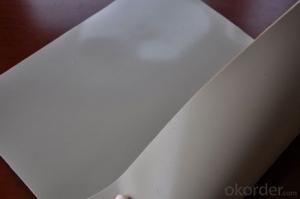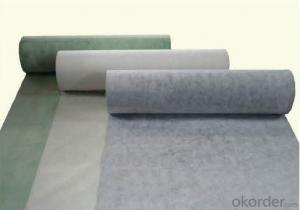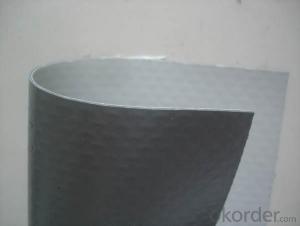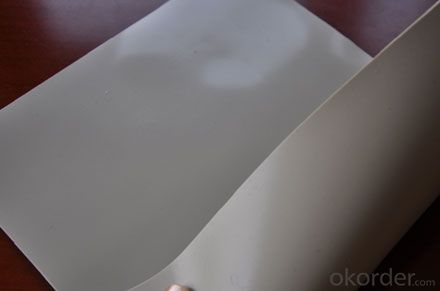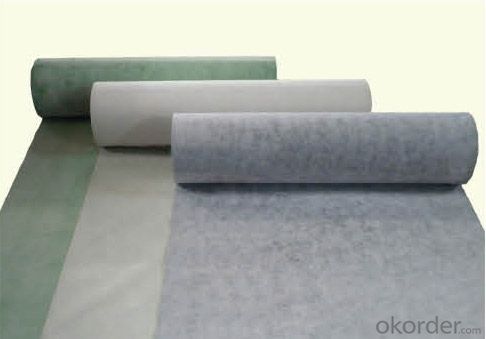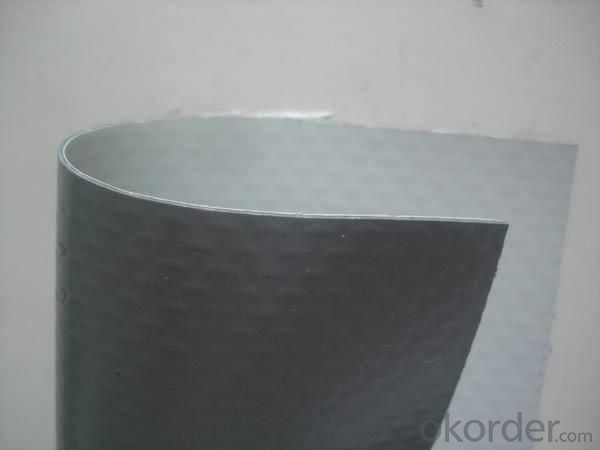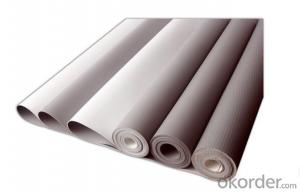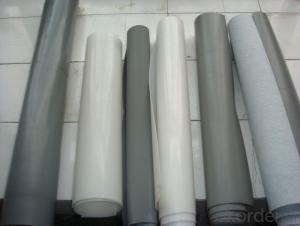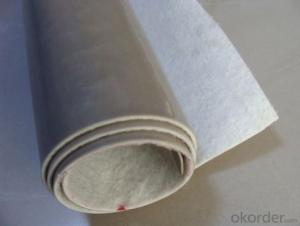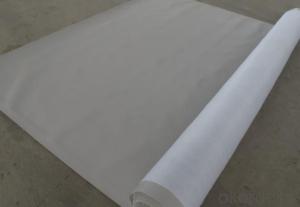Polyvinyl Chloride Waterproof Membrane Roll
- Loading Port:
- China main port
- Payment Terms:
- TT OR LC
- Min Order Qty:
- 5000 m²
- Supply Capability:
- 100000 m²/month
OKorder Service Pledge
OKorder Financial Service
You Might Also Like
Specification of PVC Waterproofing Membrane
Length | 20m/roll or customized |
Width | 2.05m |
Thickness | 1.2mm; 1.5mm; 2.0mm |
Type | Homogeneous, Reinforced, Fabric back |
If Exposed | Exposed and Non-exposed |
Color | White, Grey or customized |
Introduction of PVC Waterproofing Membrane
Polyvinyl Chloride (PVC) waterproof membrane is a new polymer waterproof membrane which is made from polyvinyl chloride resin, and mixed with plasticizer, filler, antioxygen, ultraviolet absorber and other auxiliaries.
Features of PVC Waterproofing Membrane
1) Excellent aging resistance. Service life of roofing material is over 20 years;
service life of underground material is over 50 years.
2) Root resistant penetration, specially used on planting roof.
3) Welding installation. Joints are solid and environment friendly, no pollution.
4) High tensile strength, good elongation and dimensional stability.
5) Good plasticity, easy and suitable for details installation.
6) Fireproof. Fire extinguished out of the ignition resource.
7) Surface is smooth, no fading and dirty resistant.
Types of PVC Waterproofing Membrane
N1—Exposed PVC waterproof membrane.
(It is mainly used as details treatment for exposed roof waterproof project)
N2—Non-exposed PVC waterproof membrane.
(It is mainly used as details treatment for non-exposed roof waterproof project)
L1—Exposed PVC waterproof membrane with fabric.
(It is mainly used for exposed roof waterproof project)
L2—Non-exposed PVC waterproof membrane with fabric.
(It is mainly used for non-exposed roof waterproof project)
W1—Exposed reinforced PVC waterproof membrane .
(It is mainly used for steel structure roof exposed waterproof project)
W2—Exposed reinforced PVC waterproof membrane .
(It is mainly used for steel structure roof non-exposed waterproof project)
FAQ of PVC Waterproofing Membrane
a.Can we get some samples before place order?
Answer: We can send the free samples to you by freight collect.
b.How many years can your PVC membrane guarantee?
Answer: We will guarantee the quality for 5 years at least.
c.Which countries you ever export the product?
Answer: We export the PVC membrane to South Africa, Middle east and even European countries.
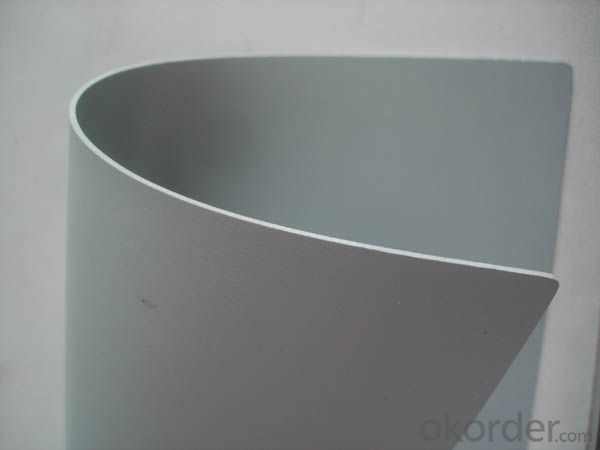
- Q: Can a waterproofing membrane be used on precast chrome surfaces?
- Yes, a waterproofing membrane can be used on precast chrome surfaces. Waterproofing membranes are often used to protect surfaces from water damage and prevent moisture from seeping into the structure. Precast chrome surfaces can also benefit from the application of a waterproofing membrane to ensure their longevity and durability. The membrane will create a barrier between the surface and any potential water intrusion, thereby protecting the precast chrome and maintaining its appearance and functionality. It is important to choose a waterproofing membrane that is compatible with chrome surfaces and follow the manufacturer's instructions for proper application.
- Q: Can a waterproofing membrane be used for exterior foundation walls?
- Yes, a waterproofing membrane can be used for exterior foundation walls. Waterproofing membranes are specifically designed to provide a barrier against water penetration and can be applied to the exterior surface of foundation walls to prevent moisture infiltration. This helps in protecting the foundation from potential damage caused by water, such as leaks, cracks, and deterioration.
- Q: Can a waterproofing membrane be used for theaters or concert halls?
- Theaters and concert halls can benefit greatly from the use of waterproofing membranes. These membranes are commonly employed in construction projects to safeguard buildings against water damage by preventing water infiltration. They are applied to various surfaces, including walls, floors, and roofs, creating a barrier that stops water from seeping through. In the case of theaters and concert halls, where the protection of the building structure and equipment is of utmost importance, waterproofing membranes can be extremely advantageous. They play a crucial role in preventing water damage to delicate equipment like audiovisual systems, lighting fixtures, and musical instruments. Furthermore, these membranes ensure a dry and comfortable environment for both performers and audience members by preventing water leakage and moisture buildup. In conclusion, the use of a waterproofing membrane in theaters or concert halls guarantees the longevity and functionality of the building, creating a safe and enjoyable experience for all involved.
- Q: Can a waterproofing membrane be used for a retaining wall?
- Yes, a waterproofing membrane can be used for a retaining wall.
- Q: Can a waterproofing membrane be used for power plants?
- Yes, a waterproofing membrane can be used for power plants. Waterproofing membranes are commonly used in power plants to protect the structural elements and equipment from water damage and leakage. These membranes are designed to provide a durable, watertight seal that can withstand the harsh conditions and high moisture levels typically found in power plant environments. Additionally, they also help in preventing corrosion and extending the lifespan of the power plant infrastructure.
- Q: Can a waterproofing membrane be installed by a homeowner, or is professional installation necessary?
- Depending on the complexity and scale of the project, a homeowner may choose to install a waterproofing membrane themselves or hire professionals. Waterproofing membranes serve to prevent water penetration in basements, roofs, or shower enclosures. For uncomplicated tasks like sealing a small basement crack, homeowners with some DIY experience can typically handle the installation of a waterproofing membrane. The market offers a variety of do-it-yourself products that come with user-friendly instructions. These products often include self-adhesive membranes or liquid waterproofing coatings that can be applied using a brush or roller. However, for larger or more intricate waterproofing projects, it is advisable to seek professional assistance. Professional waterproofing companies possess the necessary expertise, specialized tools, and experience to ensure a proper and long-lasting installation. They can assess the specific requirements of the project, identify potential problem areas, and recommend the most suitable waterproofing membrane system. Additionally, professional installation typically includes warranties that provide peace of mind and protection against future issues. To summarize, while homeowners can handle small and straightforward waterproofing projects, it is recommended to consult professionals for larger or more complex installations to achieve optimal results and long-term durability.
- Q: Are waterproofing membranes resistant to diesel fuel?
- Yes, waterproofing membranes are generally resistant to diesel fuel.
- Q: Can a waterproofing membrane be used on vinyl surfaces?
- Yes, a waterproofing membrane can be used on vinyl surfaces. Vinyl surfaces, such as vinyl flooring or vinyl siding, are commonly found in many residential and commercial buildings. Waterproofing membranes are designed to create a barrier against water and moisture, preventing them from seeping into the underlying materials. These membranes can be applied over vinyl surfaces to provide an additional layer of protection, ensuring that the vinyl remains unaffected by water damage or deterioration. It is important to select a waterproofing membrane that is compatible with vinyl surfaces and follow the manufacturer's instructions for proper application.
- Q: Can waterproofing membranes be used on roofs?
- Roofs can indeed benefit from the application of waterproofing membranes. These membranes serve the purpose of establishing a protective barrier that thwarts water infiltration. In order to accomplish this, the membranes are carefully crafted using materials such as modified bitumen, EPDM, PVC, or TPO, all of which boast remarkable water resistance capabilities and are proficient at sealing roofs. Their usage spans across various settings, including residential and commercial environments, where they prove to be invaluable for flat roofs, low-slope roofs, and even specific sloped roof designs. Employing multiple layers of waterproofing membranes ensures optimal safeguarding against water-related harm and significantly prolongs the roof's lifespan by averting leaks and moisture accumulation.
- Q: Can a waterproofing membrane be used on stone surfaces?
- Yes, a waterproofing membrane can be used on stone surfaces. Stone surfaces, such as natural or manufactured stone, can benefit from the application of a waterproofing membrane to prevent water penetration and protect against moisture-related issues. Waterproofing membranes are designed to create a barrier against water and other liquids, preventing them from seeping into the stone and causing damage. This can be particularly important for exterior stone surfaces that are exposed to rain, snow, and other weather conditions. Additionally, using a waterproofing membrane on stone surfaces can help prolong the lifespan of the stone by reducing the risk of cracks, spalling, and other forms of deterioration caused by water absorption. It is essential to choose a waterproofing membrane specifically formulated for stone surfaces to ensure proper adhesion and long-lasting protection.
Send your message to us
Polyvinyl Chloride Waterproof Membrane Roll
- Loading Port:
- China main port
- Payment Terms:
- TT OR LC
- Min Order Qty:
- 5000 m²
- Supply Capability:
- 100000 m²/month
OKorder Service Pledge
OKorder Financial Service
Similar products
Hot products
Hot Searches
Related keywords
